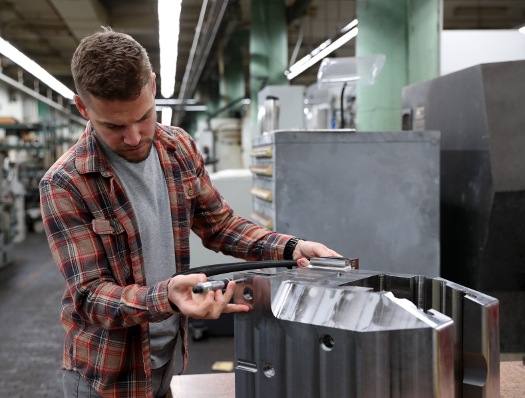 |
| January 21, 2020 | Volume 16 Issue 03 |
Designfax weekly eMagazine
Archives
Partners
Manufacturing Center
Product Spotlight
Modern Applications News
Metalworking Ideas For
Today's Job Shops
Tooling and Production
Strategies for large
metalworking plants
Army smart machining solution aims to drive down cost, deliver better weapons

Dylan Kusaywa, CCDC Armaments Center Mechanical Engineering Technical, uses the optimal production plan developed via Smart Machining Solution technologies to produce the XM35 (low-recoil gun system) Breech Ring. He measures the XM35 Breech Ring to ensure it complies with the technology data package. [Photo Credit: U.S. Army photo]
By Argie Sarantinos, U.S. Army Combat Capabilities Development Command (CCDC), Aberdeen Proving Ground, MD
For Soldiers in the field, having the right weapons is critical to winning battles. These weapons systems, which range from cannons and mortars to vehicle armor kits, will not only improve readiness and modernize the Army, but also protect Soldiers. To improve the efficiency of producing weapon systems, the Army is using Smart Machining Solution, or SMS, to research and design weapons and deliver capabilities more quickly to Soldiers.
With funding provided by the Army's Manufacturing Technology program, a team consisting of the U.S. Army Combat Capabilities Development Command Armaments Center Benét Labs and Watervliet Arsenal is using SMS to improve production of weapons systems.
"Intelligent machining solutions will help the arsenal produce components, parts, pieces, and systems for Soldiers faster, and perhaps better, with more efficient machining operations. The more efficient we make the arsenal, then the better products we will deliver to Soldiers," said John Snyder, CCDC AC senior mechanical engineer.
When manual machining was replaced by digitally controlled machines during the last decade, tool management became more complex. Tens of thousands of tools are located in arsenals and depots, and each operation requires very specific tools. SMS uses virtual reality, coupled with five smart machining modules, to choose the best tools and materials for each project and document the manufacturing process.
"The vision is to make all the modules work together to have an overall smart manufacturing solution. The SMS will allow the production engineer to easily document manufacturing processes through a digital manufacturing consultant and an automated subject matter expert system consisting of five modules," Snyder said.
The five smart machining modules include:
- Tooling database module: a library of cutting tools, based on a System Application and Product software program, which enables a plug-and-play functionality for vendors and provides a mechanism to share standardized tooling information with each smart machining solution module.
- Tool selection engine module: identifies both available and correct cutting tools for various types of manufacturing. The module uses virtual reality to choose the best tool, generate the manufacturing steps, and conduct test runs.
- Parameter optimization engine module: uses a science-based algorithm to suggest cutting parameters based on the cutting tools, workpiece material, and machine selection.
- Prioritization interface module: optimizes an operator's time and determines how much time is needed to use a specific tool.
- Process knowledge base module: captures best practices. This module will be beneficial to teach junior operators how to operate specific tools more quickly.
Plans for FY20 include integrating the modules and ensuring they are on the secure, certified Defense Research and Engineering Network. After the modules are fully integrated, the team will begin demonstrations, final testing, debugging, and transition.
Benét Laboratories, which is part of CCDC AC, is a Department of the Army research, development, and engineering facility located at Watervliet Arsenal. Watervliet Arsenal is an Army-owned and operated manufacturing facility in upstate New York. It is the only Department of Defense site where research (product and process), design, and machining are co-located in one area. On-site engineering mitigates schedule risk by enabling engineers to observe first-hand variances and correct any problems. Co-location also enables a more efficient transition of the smart machining technology from prototyping to low-rate initial production.

Kusaywa uses automated features within the Smart Machining Solution digital manufacturing consultant to develop a parts program and select cutting tools and optimal cutting parameters for a cannon mechanism component. [Photo Credit: U.S. Army photo]
To meet the Army's smart machining requirements, one of the challenges is securing and maintaining a highly skilled workforce, including programmers, journeymen, machinists, and engineers. When machines were introduced during the industrial revolution and the 20th century, a lot of manufacturing expertise moved overseas, creating a gap in U.S commercial and defense workforce. Also, many of the machine tools that were made in the U.S. are now produced overseas.
Another challenge is ensuring the workforce maintains its skillset, particularly as the commercial sector is advancing manufacturing operations very rapidly. The Armament University, which is operated by CCDC AC, offers courses and on-the-job training for entry level, journeymen in various fields, and engineers and scientists.
The team overcame a data interoperability challenge by using select standards, such as ISO 13399, which allows tooling vendors to plug their library of tools into a government solution; it also provides a mechanism to pass standardized tooling information to each SMS module.
By partnering with the S&T community, as well as the organic and defense industrial bases, the ManTech program drives down costs by introducing new manufacturing processes, such as SMS, that are more efficient and will make better products for Soldiers.
"Ultimately, SMS will help standardize and optimize production, increase efficiency and quality, and reduce production time," Snyder said.
The U.S. Army Combat Capabilities Development Command (CCDC) was formerly called the U.S. Army Research, Development and Engineering Command (RDECOM).
Published January 2020
Rate this article
View our terms of use and privacy policy
